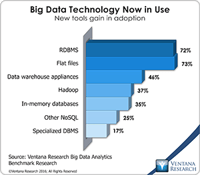Some followers of Ventana Research may recall my work here several years ago. Here and elsewhere I have spent most of my career in the data and analytics markets matching user requirements with technologies to meet those needs. I’m happy to be returning to Ventana Research to resume investigating ways in which organizations can make the most of their data to improve their business processes; for a first look, please see our 2016 research agenda on Big Data and Information Optimization. I relish...
Read More
Topics:
Big Data,
Predictive Analytics,
Analytics,
Business Analytics,
Business Intelligence,
Information Management,
Internet of Things,
Operational Intelligence,
Uncategorized,
Unicorns,
IT Performance Management (ITPM)
As a technology, predictive analytics has existed for years, but adoption has not been widespread among businesses. In our recent benchmark research on business analytics among more than 2,600 organizations, predictive analytics ranked only 10th among technologies they use to generate analytics, and only one in eight of those companies use it. Predictive analytics has been costly to acquire, and while enterprises in a few vertical industries and specific lines of business have been willing to...
Read More
Topics:
Data Scientist,
Predictive Analytics,
Sales Performance,
Social Media,
Supply Chain Performance,
Analytics,
Business Analytics,
Business Intelligence,
Customer & Contact Center,
Workforce Performance,
IT Performance Management (ITPM)
In our definition, information management encompasses the acquisition, organization, dissemination and use of information by organizations to create and enhance business value. Effective information management ensures optimal access, relevance, timeliness, quality and security of this data with the aim to improve organizational performance. This goal is not easily met, especially as organizations acquire ever more data at an ever faster pace. In our business analytics benchmark research of more...
Read More
Topics:
Data Quality,
Master Data Management,
Social Media,
Analytics,
Business Analytics,
Business Intelligence,
Cloud Computing,
Complex Event Processing,
Data Governance,
Data Integration,
Information Applications,
Information Life Cycle Management,
Information Management,
Operational Intelligence,
IT Performance Management (ITPM)
About 30 years ago, perhaps on this very day, I was sitting in front of an Apple II working on a VisiCalc spreadsheet. At the time, I don’t think I even knew who Steve Jobs was. I wasn’t in the software industry yet. I was working for a public accounting firm. The Apple II sat in a corner of the office “typing pool.” For those of you who don’t know what a typing pool was, there was no swimming involved – it was a group of full-time employees with dedicated equipment who did all the typing and...
Read More
Topics:
Mobile,
Sales Performance,
Social Media,
Supply Chain Performance,
Sustainability,
Business Analytics,
Business Collaboration,
Business Intelligence,
Business Mobility,
Business Performance,
Customer & Contact Center,
Financial Performance,
Governance, Risk & Compliance (GRC),
Information Applications,
Information Management,
Location Intelligence,
Operational Intelligence,
Visualization,
IT Performance Management (ITPM)
Splunk may be one of the biggest software companies you’ve never heard of. I’ve been following the seven-year-old company for over six months now and recently attended its second annual user conference. Splunk focuses on analyzing large volumes of machine-generated data in underlying applications and systems, which includes application and system logs, network traffic, sensor data, click streams and other loosely structured information sources. Many of these “big data” sources are the same...
Read More
Topics:
Big Data,
Predictive Analytics,
Sales Performance,
Social Media,
Supply Chain Performance,
Business Analytics,
Business Intelligence,
Business Performance,
Customer & Contact Center,
Machine data,
Operational Intelligence,
IT Performance Management (ITPM)
Last week I attended the IBM Big Data Symposium at the Watson Research Center in Yorktown Heights, N.Y. The event was held in the auditorium where the recent Jeopardy shows featuring the computer called Watson took place and which still features the set used for the show – a fitting environment for IBM to put on another sort of “show” involving fast processing of lots of data. The same technology featured prominently in IBM’s big-data message, and the event was an orchestrated presentation more...
Read More
Topics:
Big Data,
EMC,
Analytics,
Business Analytics,
Business Intelligence,
Cloud Computing,
Cloudera,
Customer & Contact Center,
Greenplum,
IBM,
Information Applications,
Information Management,
InfoSphere,
Location Intelligence,
Operational Intelligence,
IT Performance Management (ITPM),
Strata+Hadoop
As part of our largest-ever research study on business analytics, which surveyed more than 2,600 organizations covering the maturity and competency of business, IT and vertical industries, we looked at how IT is applying analytics to support their own business activities. One of the things we found is that, charged with enabling business units to use information systems as effectively as possible, the IT department, like the shoemaker’s barefoot children in the old tale, typically stands last...
Read More
Topics:
Predictive Analytics,
Analytics,
Business Analytics,
Business Intelligence,
Business Performance,
Information Applications,
Information Management,
Information Technology,
IT Analytics,
IT Service Management,
ITIL,
ITSM,
IT Performance Management (ITPM)
The information management (IM) technology market is undergoing a revolution similar to the one in the business intelligence (BI) market. We define information management as the acquisition, organization, control and use of information to create and enhance business value. It is a necessary ingredient of successful BI implementations, and while some vendors such as IBM, Information Builders, Pentaho and SAP are in addition integrating their BI and IM offerings, each discipline involves...
Read More
Topics:
Data Quality,
Social Media,
Analytics,
Business Analytics,
Business Collaboration,
Business Intelligence,
Business Technology,
CIO,
Complex Event Processing,
Data Governance,
Data Integration,
Information Management,
Information Technology,
Operational Intelligence,
IT Performance Management (ITPM)
The business intelligence (BI) technology market is undergoing a revolution. I’ve been working in this segment for 20 years, and it is and has been an exciting market in which to work, but its dynamic nature can be daunting to organizations trying to evaluate, purchase and deploy BI to improve their business processes. And despite the advances our benchmark research shows high levels of dissatisfaction with and immaturity in BI capabilities within organizations.
Read More
Topics:
Sales Performance,
Social Media,
Supply Chain Performance,
Business Analytics,
Business Collaboration,
Business Intelligence,
Business Mobility,
Business Performance,
Business Technology,
CIO,
Cloud Computing,
Collaboration,
Customer & Contact Center,
Enterprise Software,
Financial Performance,
Information Technology,
Mobility,
Operational Intelligence,
IT Performance Management (ITPM)
I recently attended SAS Institute’s annual analyst conference. My colleague covered the multibillion-dollar company’s strategy and the event. Now I want to look into some of the details of SAS’s products for business analytics and how they are supported with business intelligence (BI), and information management. Although SAS is not a publicly traded company and therefore is not required to make the financial disclosures that others are, the company revealed numerous financial statistics....
Read More
Topics:
SAS,
Social Media,
Analytics,
Business Intelligence,
Business Performance,
Business Technology,
CIO,
Collaboration,
Enterprise Software,
Information Management,
Information Technology,
Mobility,
Operational Intelligence,
IT Performance Management (ITPM)












